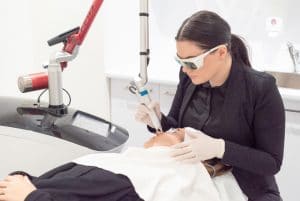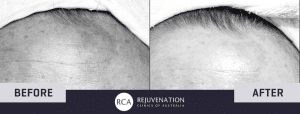28 June, 2020

Of all the different products and laser treatments promising to treat your pigmentation, which one is best? Senior Dermal Clinician Rachael from Rejuvenation Clinics of Australia says that it depends on the type of pigment you have. She spoke to us about types of pigmentation, treatments and products. She also weighed in on why winter might be the best time to start evening out your skin tone and what are the best treatments for pigmentation.

There are different types of pigmentation, and Rachael says that it’s important for her to assess your skin and determine the type of pigmentation before recommending a pigmentation treatment plan.
There is hormonal pigmentation such as melasma. This is common during pregnancy or while taking contraceptive medication. Rachael describes melasma as a blotted pigment that can appear in blocks on the upper lip, cheeks or forehead. It tends to be symmetrical, so if you have it on one cheek, it’ll normally appear on the other cheek as well, she says.
Other types of pigmentation that Rachael describes include sun damage, caused by UV radiation. This appears as spotted pigment over the face and body. There are also solar lentigos which are larger spots caused by UV exposure. Then there are freckles, which are technically another type of pigmentation, and they normally appear if you’re more genetically predisposed. In most cases, UV radiation is the leading cause.
“With the sun in Australia being so strong, we tend to get a lot of patients who do have quite a lot of pigment, or people who have moved from overseas to Australia who tend to notice that they’re developing pigmentation. UV radiation is the leading cause, and it can also worsen existing forms of pigment,” Rachael says.
There is also pigmentation caused by acne. Sometimes after adult acne heals, you are left with red or brown pigmented scars.
When you go to Rejuvenation Clinics of Australia, they take clinical photos and apply a special filter that gives the Dermal Clinician insights into the pigmentation in your skin. “It looks like a black and white filter,” Rachael says, “and what it does is show the type of pigment you have and how deeply it is sitting in the skin. What we’ll find sometimes is that patients can have layers of different types of pigment, so they might have that deep hormonal melasma, but then they can also have the sun spots on top of that, so it’s a really great way for us to determine what types of pigment the patient does have, and from there we can determine what the best treatment plan will be. We really have so many different modalities and lasers, so the filters are a great tool for us to customise the treatment plan.”
As mentioned above, the way your pigmentation is treated should really depend on the type of pigment you have.
Rachael says that the Erbium laser is great for targeting superficial pigmentation, such as pigmentation left from acne scarring or superficial sun damage. It’s a resurfacing laser that gently removes the surface layer of pigmented skin cells. Then the healthy, new layer of skin cells can come through.
For deeper pigmentation, and especially for hormonal pigmentation, Rachael recommends Pico Rejuvenation Laser Toning because it uses vibrational energy to gently shatter the pigment that’s trapped beneath the skin, without breaking through the skin’s surface. The body then sees that shattered pigment as waste product and removes it naturally. “There is no heat involved with our Pico laser, so it’s much safer for hormonal pigmentation which can be more sensitive to heat,” Rachael explains.
First and foremost, she recommends coming in for a free face-to-face consultation so a Dermal Clinician can assess your skin’s condition and make a personalised recommendation.
Rachael believes that your at-home skincare is just as important as your in-clinic treatments, so long as you’re using active medical grade products. “We can treat the pigment and make it lighter, but it can come back later on if you are not looking after your skin. The right products can help you maintain your results for a prolonged period of time.”
Sunscreen is the most important, Rachael says, because so much pigmentation is caused by UV radiation. Even with hormonal pigmentation, UV rays can trigger a flareup.
Her second most important product is a pigment inhibiting serum. Pigmentation is an inflammatory skin condition, so a pigment inhibitor can calm inflammation from the melanocytes (the pigment-producing cells) and reduce the overproduction of pigmentation. “I almost see it as sedating the pigment producing cells,” Rachael says.
Some pigment inhibiting ingredients, such as Beta-White and Sepi-White, help slow pigment production in the melanocyte and stop the pigment from the melanocyte from entering the regular skin cells where pigment becomes visible. Symwhite is an ingredient that does this but also helps to break down existing pigment and brighten the skin tone.
Rachael’s go-to pigment inhibitor is RejuvAus S2 Whitening & Brightening Pigment Serum because it has all three pigment inhibitors to reduce and prevent pigmentation from different angles.
Antioxidants are also important because they protect the skin from oxidisation. Rachael explains that “if you bite into an apple and you put it out, and you leave it out, what tends to happen is it turns brown, so that is actually an oxidisation process happening. By using antioxidants, you’re protecting those skin cells from that oxidising, pigmenting process.”
For antioxidants, Rachael says you can look to your ABC’s. Vitamin A helps to regulate the way the pigment producing cells are working. Vitamin B (B3 Niacinamide, specifically) is a potent anti-inflammatory, which helps because pigmentation is an inflammatory skin condition. Vitamin C brightens and lightens skin pigment. All three vitamins also work as antioxidants to fight free radical damage.
Rachael loves RejuvAus S1 ABC Repair & Restore Antioxidant Serum because it has all three antioxidants in one bottle.
Exfoliants are also helpful because they lift and shift pigmented cells off the skin to let the new healthy layer of cells through and help to regulate the way the skin is functioning.
You can treat pigmentation in any season, but it’s certainly a more popular winter treatment. There once was a time when laser treatments involved a lot of downtime, so people preferred to do them in winter when they could stay in. With the current technologies, you can accomplish a lot with no downtime afterwards, but winter is still a more popular time to do laser treatments for pigmentation.

Rachael thinks that it might have to do with treatment times and UV levels. Pigmentation is rarely fixed by a one-off treatment. You’ll likely need several treatments, and for best results, you need to avoid UV exposure between treatments. It’s easier to do this in winter as UV levels tend to be a bit lower and people spend less time outside.
Lower UV levels doesn’t mean no UV in the atmosphere, so you should still wear sunscreen all year, she notes.
For more information, or to book your complimentary consultation and skin assessment, visit Rejuvenation Clinics of Australia’s website!

Leave a Reply